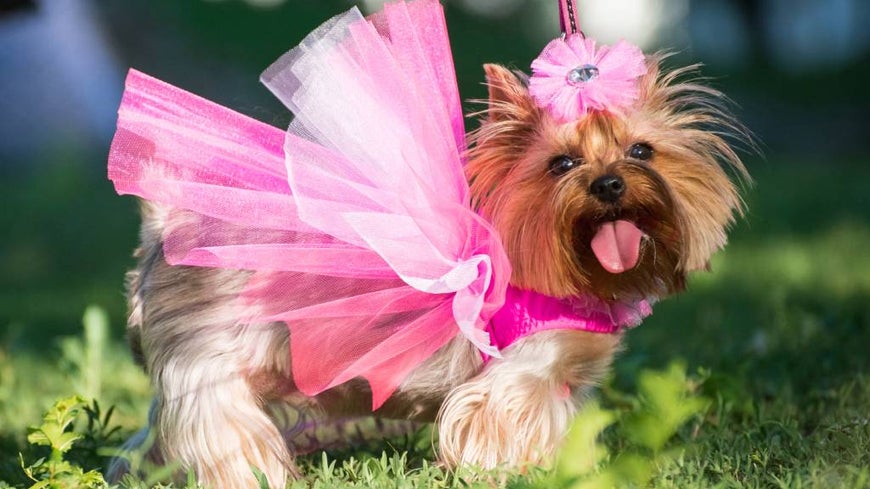On the cat (dog) walk

Written by Monique Butterworth for Seniors Pet Insurance.
Part fashion, part mindfulness, the power of dopamine dressing – where the clothing you wear can impact your mood – is well recognised. Playing with pets, too, can increase the production of dopamine (a neurotransmitter that plays a vital role in our brain’s pleasure zone) and reduce our stress levels. So, surely opting for an amazing outfit for you and your pet brings a dopamine double-dose?
It seems likely, if the soaring growth in the four-legged fashion market is any indication. Last year, fashion houses such as Gucci, Christian Louboutin, Celine, Hugo Boss and Tommy Hilfiger all launched designer ranges for furry fashionistas. Earlier this year, Australian designers Romance Was Born, The Upside and Double Rainbouu collaborated with pet brand Petstock, hitting the runway with pieces for fashionable pooches and their equally on-trend humans.
Country music icon Dolly Parton is even in on the act, recently launching her collection of pet apparel under the label Doggy Parton, available in Australia at Petbarn. The rise of the fashion-forward pet has coincided with the surge of pet influencers on Instagram and TikTok. It’s also a popular trend with the over 50s, with the Australian Seniors: For the Love of Pets Report 2023 finding that 14% of dog owners, and 6% of cat owners, splash out on pet fashion items.
How can we ensure our beloved, furry friends don’t become fashion victims? Dog behaviour expert and Petstock ambassador Lara Shannon says it’s important we understand that our pets have very different needs. “For some dogs, dressing them up in costumes or other clothing can cause stress and anxiety,” she says. “It can put them physically in danger of being hurt. It’s important to be aware of how it makes them feel and ensure nothing covers their ears, restricts their vision or movement or irritates their skin.”
Watch for signs of stress in your dog, such as excessive licking of lips, repeated yawning, dribbling and drooling, panting, trembling and excessive seeking of attention.
Are there negative impact of dressing up a pet?

“Costumes can also impact a dog’s behaviour, particularly if there are other dogs around. It can make them feel vulnerable or restricted and can put them in danger, as the other dog may be unable to read their body language – which is a key part of how dogs communicate and important for those initial interactions.”
Lara says cats are far less tolerant of dress-ups. “Costumes are not something I recommend at all for cats, other than something not restrictive, such as a bandana or bow tie. But even then, some cats will freak out. Watch out for angry, flicking tails or a cat trying to get away – they are not happy!”
Clothing such as dog coats, however, are recommended for certain breeds to stay warm in winter. “But it’s important to take the coat off when it’s no longer needed, such as when they are running around at the park or inside when it’s warm, otherwise they can overheat or get matted hair.”
A correctly fitting coat is a must, Lara advises. “A coat should be snug, but not so tight it hinders the dog’s movements, causes a rash or cuts into their skin. You don’t want the coat to put weight on their tail or restrict their ability to toilet freely with no mess,” she adds. “Always check the neckline – you need to be able to put three flat fingers comfortably underneath it.”
What pet costumes should be avoided?

Bow ties and bandanas – while cute – can have their downsides too. “Again, always make sure you can put three flat fingers comfortably underneath the bow tie or bandana when doing them up. Be careful the dog doesn’t keep trying to bite at it as they could get their jaw trapped. Likewise, with their paw and nails,” says Lara. “If your dog does manage to get it off, they might start chewing or ingest it.”
Pets are considered such an important part of the family, it can certainly make us feel good to dress our pooch in the latest must-have accessory and have something to post on social media. However, this can be at the expense of their wellbeing.
“Many dog owners do tend to anthropomorphise their dogs, attributing human characteristics to them and treating them like mini-humans. Dressing them up in clothing is one of the most common ways people do this,” says Lara.
“This can lead to confusion, stress and anxiety in our pets, affecting them physically by elevating their heart rate, impacting on gut health and increased alertness or hypervigilance.
Did you know?
Dog Dressing Steps
By Lara Shannon
- To get your pet comfortable wearing a coat, costume, bow tie or bandana, start slowly and calmly, and never force your dog to put anything on.
- Let them sniff and get used to the item, using treats to praise calm behaviour.
- Ask them to stand or sit and use positive reinforcement training to slowly put it on their back or put one paw in. Avoid sudden movements.
- If your pet reacts, always go back one step. Always reward desired behaviour.
- Never punish a reaction. Instead, stop and give them a break.
- Get someone to help you if needed. They could dispense the treats as you put the item on to avoid confusing or stressing your dog
Dressing up pets is fun but it’s important to consider taking out cover for when your pet gets into mischief. Seniors Pet Insurance provides cover for your pet for accidental injuries and illness.
27 Dec 2023